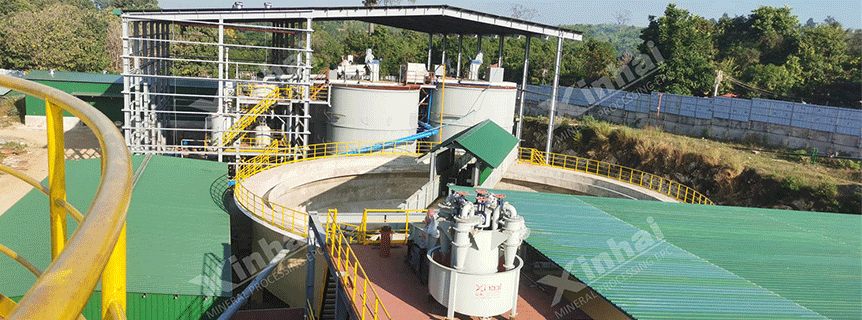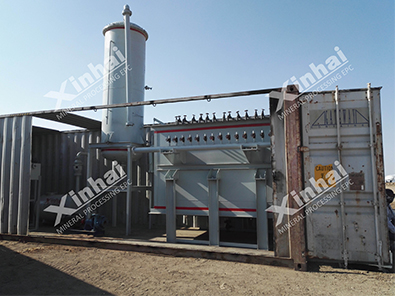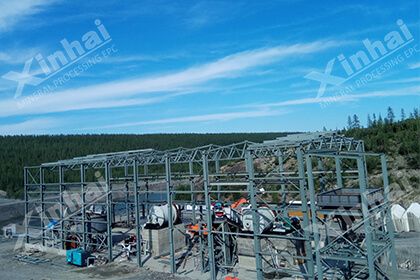Gold Leaching Process and Equipment
 Sheena
Sheena
 Dec 08, 2024
Dec 08, 2024
 693
693
If you want to know more details about equipment, solutions, etc, please click the button below for free consultation, or leave your requirements!

Myanmar-500tpd-Gold-Mine-CIL-Concentrator
01Introduction to Gold Leaching
BackThe gold leaching process is a method used to extract gold from its ore, typically involving chemical reactions. It is commonly used in mining operations, especially for ores with low gold content. The two primary leaching processes used in gold extraction are cyanidation and thiosulfate leaching. Here's an overview of the process and the equipment involved:

02Cyanidation (Gold Cyanide Process)
Back1. Process Steps
Crushing and Grinding: The gold ore is first crushed and ground into fine particles to increase the surface area for leaching.
Leaching: The ground ore is then treated with a cyanide solution (typically sodium cyanide, NaCN). Gold is dissolved into the cyanide solution as a gold-cyanide complex.
Separation: The gold-bearing cyanide solution is separated from the solid ore. This can be done through methods like gravity separation, filtration, or decantation.
Recovery: The gold is then recovered from the cyanide solution, typically through carbon-in-pulp (CIP), carbon-in-leach (CIL), or zinc precipitation.
2. Cyanidation Equipment
Ball Mills: Used to crush and grind the ore into a fine powder.
Leach Tanks: Large tanks where the cyanide solution is mixed with the ore to dissolve the gold.
Carbon Columns or CIP/CIL Tanks: These are used to adsorb the dissolved gold onto activated carbon (in CIP) or while the gold is leached (in CIL).
Filters: Used to separate solid waste material from the gold-laden solution.
Zinc Precipitation Units: In some processes, zinc dust is added to the cyanide solution to precipitate gold as a solid.
Electrowinning Cells: Where gold is recovered from the solution by an electrochemical process.



03Thiosulfate Leaching (Non-Cyanide Leaching)
BackThiosulfate leaching is an alternative to cyanidation that uses a thiosulfate solution (typically sodium thiosulfate) to dissolve gold. It is considered more environmentally friendly than cyanide but can be less efficient.
1. Thiosulfate Leaching Process Steps
Crushing and Grinding: Similar to cyanidation, the ore is crushed and ground to increase surface area.
Leaching: The ore is treated with a thiosulfate solution. Gold forms a thiosulfate complex (Au(S₂O₃)₂³⁻).
Separation and Recovery: Gold is separated from the thiosulfate solution and recovered using carbon adsorption or resin-in-pulp (RIP) methods.
2. Thiosulfate Leaching Equipment
Ball Mills: Used for grinding the ore.
Leach Tanks: Where the ore is mixed with thiosulfate solution to dissolve the gold.
Carbon Adsorption Columns: For recovering gold from the solution (similar to carbon-in-pulp or carbon-in-leach processes in cyanidation).
Filters: To remove solid waste.
Electrowinning Cells: For gold recovery from the solution.



04Alternative Gold Leaching Methods
Back1. Heap Leaching
Heap leaching involves stacking ore into piles and sprinkling cyanide solution to percolate through, leaching gold. It is cost-effective for low-grade ores but slower.
2. Carbon-in-Pulp (CIP) and Carbon-in-Leach (CIL)
These methods involve adding carbon to the pulp or leach solution to adsorb the gold-cyanide complex, enhancing efficiency.
05Conclusion
BackThe above is the gold leaching process and required equipment. Gold leaching, predominantly through cyanide, is a critical process in gold extraction, balancing efficiency with environmental responsibility. The success of the leaching process depends on the choice of method, the equipment used, and the specific characteristics of the ore.
If you have any questions about the gold leaching process or need the equipment mentioned, please leave a message to communicate with us or consult our online customer service.
 +86 18716000713
+86 18716000713 xlyin@xinhaimining.net
xlyin@xinhaimining.net




 Message
Message Chat Now
Chat Now




















